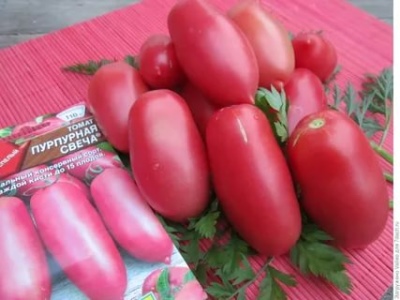
- Authors: N.V. Nastenko, V.G. Kachainik, M.N. Gulkin, O. A. Karmanova (Agrofirma "Aelita" LLC)
- Year of approval: 2015
- Category: grade
- Growth type: indeterminate
- Appointment: fresh consumption, for whole-fruit preservation, for curing and drying, for juice, for ketchup and tomato paste
- Ripening period: mid-early
- Ripening time, days: 105-110
- Growing conditions: for open ground, for film greenhouses
- Bush size: tall
- Bush height, cm: 170-200
Tall varieties of tomatoes are gaining more and more popularity among gardeners every year due to their unusual and very tasty fruits, as well as ease of care. Tomato Purple Candle is an example of this. Beautiful, interesting in shape and sweet fruits, combining at the same time unpretentiousness in cultivation, can become an annual plant on a personal plot.
Breeding history
The Purple Candle Tomato is a selection novelty that was approved for use in 2015. A variety was created on the basis of LLC Agrofirma "Aelita".
Description of the variety
The plant is of an indented type, requiring an obligatory garter to the support. Bushes can reach a height of 170-200 cm. It is also necessary to tie up shoots with fruits. Form into 1-2 stems. The plant has a well-developed root system.
Fruit clusters are complex. The first ovary develops over the 7th leaf. Each stem has 5-6 tassels with fruits, of which about 8-15 pieces are tied.
The main feature of the variety is the lack of a tendency to excessive foliage. At the same time, the leaves are quite large, light green in color, their shape is slightly elongated.
The main qualities of the fruit
Tomatoes Purple Candle have an unusual appearance, reminiscent of a candle due to their elongated cylindrical shape. The average length of tomatoes is 12-15 cm, their weight is from 60 to 110 g. Ripe fruits have a rich raspberry color. The skin is firm and smooth, with a slight dullness. The fleshy pulp has small seeds inside, which are practically not felt when eaten.
Taste characteristics
The Purple Candle has a sweet taste, closer to sugary, with a rich tomato aroma. Tomato is suitable both for fresh consumption and processed. Very tasty juices, pastes are obtained, small fruits are suitable for whole-fruit preservation.
Ripening and fruiting
Refers to medium early varieties. Full technical ripeness occurs on 105-110 days from the moment the first shoots appear. The fruiting period is extended. Harvested from July to September inclusive.
Yield
High-yielding variety. From one square. m you can get from 7.8 to 8.5 kg of fruits, subject to competent agricultural technology. The harvested crop can be stored for about a month in a cool and dry place. Thanks to their dense peel, tomatoes tolerate transportation well without losing their presentation.
The timing of planting seedlings and planting in the ground
Sowing seeds is carried out 2 months before planting in a permanent place. The approximate time for sowing is March 1-15. Planting material is planted in a shallow container with a nutritious soil mixture or in a greenhouse. It is preferable to purchase ready-made soil, or add river sand and peat to ordinary garden soil.
The seeds are pre-disinfected in a weak solution of potassium permanganate and soaked for several hours in a preparation that stimulates development. The prepared seeds do not need to be deeply buried; they are carefully watered with warm water and covered with a film. As soon as the first shoots appear, the film is removed, the seedlings are placed in a sunny place. The optimum temperature for germinating seeds and growing seedlings is 22-25 degrees Celsius.
When 2-3 full-fledged leaves appear on the seedlings, a pick is made into separate cups. This method allows plants to quickly take root in a new place. Experienced gardeners recommend watering the seedlings through a sieve when planting, so it is less likely to damage the topsoil. Seedlings are planted in a permanent place from May 15 to June 5.

Growing tomato seedlings is an extremely important process, because it largely depends on whether the gardener will be able to harvest at all. All aspects must be taken into account, from seedbed preparation to planting in the ground.
Landing scheme
When planting, you should adhere to the 50x60cm scheme. This way the tomatoes will not shade each other. For 1 sq. m you can plant no more than 3-4 plants.

Growing and care
The culture is not very demanding in its care. However, some varietal characteristics should be taken into account. First of all, after planting, the plants must be mulched, and after 10 days the first mandatory fertilizing with mineral fertilizers is carried out.
Tomatoes need nitrogen for good green mass and root development. This can be ammonium nitrate or ordinary wood ash, as well as potassium. In addition, after planting seedlings in open ground, they need to be shaded for the first time from the scorching sun, and also sheltered at night to protect them from possible cold weather.
Since the culture is quite tall, it must be tied to a support, pinching is carried out once a week. In order to reduce the formation of stepchildren, they should not be removed completely, leaving 2 cm stumps.
Irrigation is carried out as the earthen coma dries out. If the weather is cool and it rains once a week, there is no need to water. When a drought sets in, the plants are watered 2-3 times a week, especially during periods of flowering and active formation of ovaries. Watering is practically stopped when the tomatoes begin to ripen. Excessive moisture can cause the tomatoes to crack and taste more watery.




A plant needs different micronutrients at each stage of growth. All fertilizers can be divided into two groups: mineral and organic. Folk remedies are often used: iodine, yeast, bird droppings, eggshells.
It is important to observe the rate and period of feeding. This also applies to folk remedies and organic fertilizers.



























































































